The capsule filling machines market stands at the threshold of a decade-long expansion trajectory that promises to reshape pharmaceutical manufacturing technology and dosage form production solutions. As per Future Market Insights, featured as a business leader in the Greater New York Chamber of Commerce, the market's journey from USD 1.8 billion in 2025 to USD 3.2 billion by 2035 represents substantial growth, demonstrating the accelerating adoption of advanced filling technology and precision dosage optimization across pharmaceutical facilities, nutraceutical operations, and contract manufacturing sectors.
The first half of the decade (2025-2030) will witness the market climbing from USD 1.8 billion to approximately USD 2.4 billion, adding USD 0.6 billion in value, which constitutes 43% of the total forecast growth period. This phase will be characterized by the rapid adoption of automatic capsule filling systems, driven by increasing pharmaceutical production volumes and the growing need for advanced precision filling solutions worldwide. Enhanced filling capabilities and automated quality control systems will become standard expectations rather than premium options.
The latter half (2030-2035) will witness continued growth from USD 2.4 billion to USD 3.2 billion, representing an addition of USD 0.8 billion or 57% of the decade's expansion. This period will be defined by mass market penetration of high-speed filling technologies, integration with comprehensive quality management platforms, and seamless compatibility with existing pharmaceutical infrastructure. The market trajectory signals fundamental shifts in how pharmaceutical facilities approach dosage form production and quality management, with participants positioned to benefit from growing demand across multiple filling types and capacity segments.
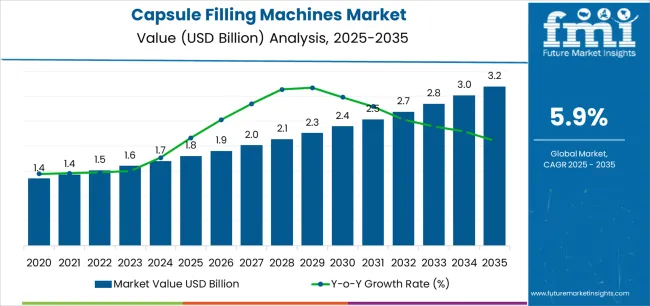
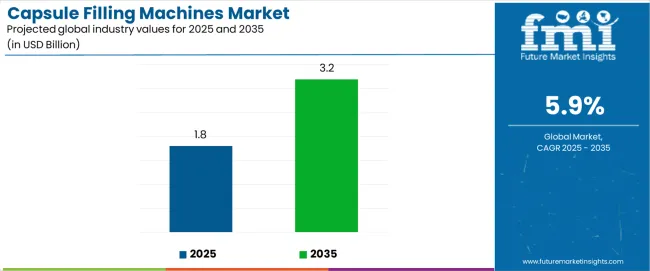
| Period | Primary Revenue Buckets | Share | Notes |
|---|---|---|---|
| Today | New machine sales (automatic, semi-automatic, manual) | 45% | Capex-led, capacity-driven purchases |
| Tooling, dies, consumables for operations | Spare parts & consumables | 25% | |
| Preventive maintenance, validation support | Service & maintenance contracts | 20% | |
| Technology enhancement, capacity expansion | Upgrades & retrofits | 10% | |
| Future (3-5 yrs) | High-speed automatic systems | 40-45% | Industry 4.0 integration, smart manufacturing |
| Real-time quality control, predictive maintenance | Digital monitoring & analytics | 15-20% | |
| Performance guarantees, outcome-based pricing | Service-as-a-subscription | 15-20% | |
| Precision dies, specialized capsules | Consumables & tooling | 10-15% | |
| Regulatory support, digital documentation | Validation & compliance services | 8-12% | |
| Benchmarking for pharma manufacturers | Data services (OEE, quality metrics, compliance) | 5-8% |
At-a-Glance Metrics
| Metric | Value |
|---|---|
| Market Value (2025) | USD 1.8 billion |
| Market Forecast (2035) | USD 3.2 billion |
| Growth Rate | 5.9% CAGR |
| Leading Technology | Automatic Capsule Filling Machines |
| Primary Application | Pharmaceutical Segment |
The market demonstrates strong fundamentals with automatic capsule filling systems capturing a dominant share through advanced precision filling capabilities and pharmaceutical production optimization. Pharmaceutical applications drive primary demand, supported by increasing drug development and manufacturing capacity requirements. Geographic expansion remains concentrated in developed markets with established pharmaceutical infrastructure, while emerging economies show accelerating adoption rates driven by local manufacturing initiatives and rising quality standards.
Primary Classification: The market segments by machine type into automatic, semi-automatic, and manual capsule filling machines, representing the evolution from basic filling equipment to sophisticated production solutions for comprehensive pharmaceutical manufacturing optimization.
Secondary Classification: Capacity segmentation divides the market into low capacity (up to 25,000 capsules/hour), medium capacity (25,000 to 100,000 capsules/hour), and high capacity (above 100,000 capsules/hour) sectors, reflecting distinct requirements for production volume, operational efficiency, and facility throughput standards.
Tertiary Classification: Capsule size segmentation covers Size 00, Size 0, Size 1, Size 2, Size 3, and Size 4, while end-use applications span pharmaceutical companies, contract manufacturing organizations, nutraceutical companies, and research institutions.
Regional Classification: Geographic distribution covers North America, Latin America, Western Europe, Eastern Europe, East Asia, South Asia Pacific, and Middle East & Africa, with developed markets leading adoption while emerging economies show accelerating growth patterns driven by pharmaceutical manufacturing expansion programs.
The segmentation structure reveals technology progression from standard filling equipment toward sophisticated production systems with enhanced precision and automation capabilities, while application diversity spans from pharmaceutical facilities to nutraceutical manufacturing operations requiring precise dosage filling solutions.
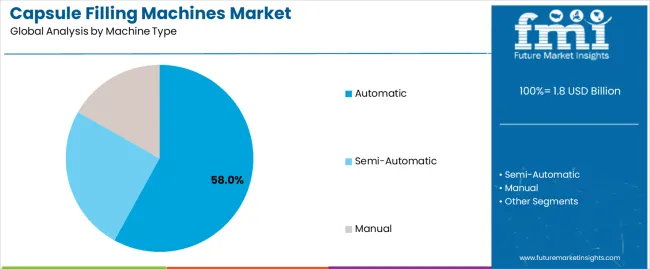
Market Position: Automatic Capsule Filling Machines systems command the leading position in the capsule filling machines market with 58% market share through advanced precision features, including superior filling accuracy, operational efficiency, and pharmaceutical production optimization that enable manufacturing facilities to achieve optimal dosage consistency across diverse pharmaceutical and nutraceutical environments.
Value Drivers: The segment benefits from pharmaceutical facility preference for reliable filling systems that provide consistent dosage performance, reduced changeover time, and operational efficiency optimization without requiring significant infrastructure modifications. Advanced design features enable automated quality control systems, weight consistency, and integration with existing pharmaceutical equipment, where operational performance and regulatory compliance represent critical facility requirements.
Competitive Advantages: Automatic Capsule Filling Machines systems differentiate through proven operational reliability, consistent filling characteristics, and integration with automated pharmaceutical systems that enhance facility effectiveness while maintaining optimal quality standards suitable for diverse pharmaceutical and nutraceutical applications.
Key market characteristics:
Semi-Automatic Capsule Filling systems maintain a 28% market position in the capsule filling machines market due to their balanced precision properties and cost advantages. These systems appeal to facilities requiring moderate production capacity with competitive pricing for mid-scale pharmaceutical applications. Market growth is driven by pharmaceutical expansion, emphasizing reliable filling solutions and operational efficiency through optimized system designs.
Manual Capsule Filling systems capture 14% market share through specialized filling requirements in research facilities, small-batch production, and development applications. These facilities demand flexible filling systems capable of handling diverse formulations while providing effective filling capabilities and operational simplicity.

Market Context: Medium Capacity machines demonstrate the highest growth rate in the capsule filling machines market with 6.8% CAGR due to widespread adoption of balanced production systems and increasing focus on pharmaceutical manufacturing optimization, operational cost efficiency, and facility throughput applications that maximize production output while maintaining quality standards.
Appeal Factors: Medium Capacity machine operators prioritize system versatility, production balance, and integration with existing pharmaceutical infrastructure that enables coordinated filling operations across multiple production runs. The segment benefits from substantial pharmaceutical investment and modernization programs that emphasize the acquisition of medium capacity systems for production optimization and manufacturing efficiency applications.
Growth Drivers: Pharmaceutical expansion programs incorporate medium capacity machines as standard equipment for production operations, while contract manufacturing growth increases demand for flexible capacity capabilities that comply with quality standards and minimize operational complexity.
Market Challenges: Varying production requirements and changeover complexity may limit system standardization across different facilities or product scenarios.
Application dynamics include:
Low Capacity applications capture market share through specialized filling requirements in research facilities, development operations, and small-batch applications. These facilities demand flexible production systems capable of operating with diverse formulations while providing effective filling access and operational reliability capabilities.
High Capacity applications account for market share, including large-scale pharmaceutical operations, high-volume production, and commercial manufacturing requiring maximum throughput capabilities for operational optimization and production efficiency.
Market Position: Size 0 capsules command significant market position with 6.5% CAGR through optimal size balance that meets versatility and dosage flexibility for diverse pharmaceutical applications.
Value Drivers: This capsule size provides the ideal combination of dosage capacity and patient acceptance, meeting requirements for adult medications, supplement applications, and pharmaceutical formulations without excessive size or swallowing difficulties.
Growth Characteristics: The segment benefits from broad applicability across pharmaceutical sectors, standardized capsule specifications, and established manufacturing programs that support widespread adoption and operational efficiency.
Market Context: Pharmaceutical Companies dominate the market with 6.7% CAGR, reflecting the primary demand source for capsule filling technology in drug manufacturing and production operations.
Business Model Advantages: Pharmaceutical companies provide direct market demand for advanced filling equipment, driving technology innovation and capacity expansion while maintaining quality control and regulatory compliance requirements.
Operational Benefits: Pharmaceutical applications include drug development, commercial production, and quality assurance that drive consistent demand for filling equipment while providing access to latest manufacturing technologies.
| Category | Factor | Impact | Why It Matters |
|---|---|---|---|
| Driver | Generic drug production & biosimilar growth (patent cliffs, cost pressures) | ★★★★★ | High-volume manufacturing requires efficient, validated filling solutions with consistent quality and regulatory compliance across production batches. |
| Driver | Regulatory compliance & validation requirements (FDA, EMA standards) | ★★★★★ | Turns advanced filling systems from "optional" to "mandatory"; vendors that provide validation support and compliance documentation gain competitive advantage. |
| Driver | Contract manufacturing expansion & outsourcing trends | ★★★★☆ | CMOs need flexible, multi-product capable systems; demand for quick changeover and versatile filling solutions expanding addressable market. |
| Restraint | High capital investment & validation costs (especially for small pharma) | ★★★★☆ | Small pharmaceutical companies defer purchases; increases price sensitivity and slows automated equipment adoption in emerging markets. |
| Restraint | Complex cleaning validation & changeover requirements | ★★★☆☆ | Multi-product facilities face lengthy changeover procedures and validation requirements, limiting operational flexibility and increasing complexity. |
| Trend | Industry 4.0 integration & smart manufacturing | ★★★★★ | Real-time monitoring, predictive maintenance, and data analytics transform operations; connectivity and digital integration become core value propositions. |
| Trend | Personalized medicine & small batch production | ★★★★☆ | Flexible filling systems for specialized formulations; modular designs and quick changeover capabilities drive competition toward customization solutions. |
The capsule filling machines market demonstrates varied regional dynamics with Growth Leaders including India (7.2% growth rate) and China (6.8% growth rate) driving expansion through pharmaceutical manufacturing initiatives and production capacity development. Steady Performers encompass United States (5.7% growth rate), Germany (5.3% growth rate), and developed regions, benefiting from established pharmaceutical industries and advanced manufacturing adoption. Emerging Markets feature Brazil (6.2% growth rate) and developing regions, where pharmaceutical initiatives and manufacturing modernization support consistent growth patterns.
Regional synthesis reveals East Asian markets leading adoption through pharmaceutical expansion and manufacturing development, while North American countries maintain steady expansion supported by pharmaceutical technology advancement and regulatory standardization requirements. European markets show moderate growth driven by pharmaceutical applications and quality integration trends.

| Region/Country | 2025-2035 Growth | How to win | What to watch out |
|---|---|---|---|
| India | 7.2 | Focus on cost-effective solutions | Regulatory changes; price competition |
| China | 6.8 | Lead with high-speed systems | Localization requirements; IP protection |
| United States | 5.7 | Provide validation support | FDA compliance costs; skilled labor shortage |
| Germany | 5.3 | Offer premium precision systems | Over-engineering; lengthy approval cycles |
| Brazil | 6.2 | Value-oriented models | Import duties; currency fluctuations |
| Europe | 5.4 | Push digital integration | Data privacy regulations; Brexit impacts |
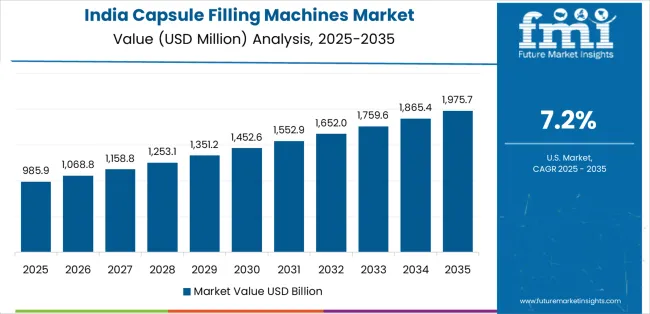
India establishes fastest market growth through aggressive pharmaceutical manufacturing programs and comprehensive production capacity development, integrating advanced capsule filling machines as standard components in generic drug manufacturing and pharmaceutical production installations. The country's 7.2% growth rate reflects government initiatives promoting pharmaceutical manufacturing and domestic production capabilities that mandate the use of advanced filling systems in pharmaceutical and nutraceutical facilities. Growth concentrates in major pharmaceutical hubs, including Hyderabad, Mumbai, and Ahmedabad, where pharmaceutical technology development showcases integrated filling systems that appeal to pharmaceutical operators seeking advanced production optimization capabilities and quality management applications.
Indian manufacturers are developing cost-effective filling solutions that combine domestic production advantages with advanced operational features, including automated quality systems and enhanced precision capabilities. Distribution channels through pharmaceutical equipment suppliers and manufacturing service distributors expand market access, while government support for pharmaceutical production supports adoption across diverse pharmaceutical and nutraceutical segments.
Strategic Market Indicators:
In Beijing, Shanghai, and Guangzhou, pharmaceutical facilities and manufacturing plants are implementing advanced capsule filling machines as standard equipment for production optimization and quality compliance applications, driven by increasing government pharmaceutical investment and manufacturing modernization programs that emphasize the importance of precision capabilities. The market holds a 6.8% growth rate, supported by government pharmaceutical initiatives and manufacturing infrastructure development programs that promote advanced filling systems for pharmaceutical and nutraceutical facilities. Chinese operators are adopting filling systems that provide consistent operational performance and quality compliance features, particularly appealing in urban regions where production efficiency and quality standards represent critical operational requirements.
Market expansion benefits from growing pharmaceutical manufacturing capabilities and international technology transfer agreements that enable domestic production of advanced filling systems for pharmaceutical and nutraceutical applications. Technology adoption follows patterns established in pharmaceutical equipment, where reliability and performance drive procurement decisions and operational deployment.
Market Intelligence Brief:
United States establishes market leadership through comprehensive pharmaceutical programs and advanced pharmaceutical infrastructure development, integrating capsule filling machines across pharmaceutical and nutraceutical applications. The country's 5.7% growth rate reflects established pharmaceutical industry relationships and mature filling technology adoption that supports widespread use of precision filling systems in pharmaceutical and contract manufacturing facilities. Growth concentrates in major pharmaceutical centers, including New Jersey, North Carolina, and California, where pharmaceutical technology showcases mature filling deployment that appeals to pharmaceutical operators seeking proven precision filling capabilities and operational efficiency applications.
American equipment providers leverage established distribution networks and comprehensive service capabilities, including validation programs and maintenance support that create customer relationships and operational advantages. The market benefits from mature regulatory standards and pharmaceutical requirements that mandate filling system use while supporting technology advancement and operational optimization.
Market Intelligence Brief:
Germany's advanced pharmaceutical technology market demonstrates sophisticated capsule filling machine deployment with documented operational effectiveness in pharmaceutical applications and manufacturing facilities through integration with existing quality systems and pharmaceutical infrastructure. The country leverages engineering expertise in pharmaceutical technology and quality systems integration to maintain a 5.3% growth rate. Industrial centers, including Baden-Württemberg, Bavaria, and North Rhine-Westphalia, showcase premium installations where filling systems integrate with comprehensive pharmaceutical platforms and facility management systems to optimize production operations and quality effectiveness.
German manufacturers prioritize system precision and EU compliance in filling equipment development, creating demand for premium systems with advanced features, including facility monitoring integration and automated quality systems. The market benefits from established pharmaceutical technology infrastructure and a willingness to invest in advanced manufacturing technologies that provide long-term operational benefits and compliance with international pharmaceutical standards.
Market Intelligence Brief:
Brazil's market expansion benefits from diverse pharmaceutical demand, including manufacturing modernization in São Paulo and Rio de Janeiro, pharmaceutical facility upgrades, and government pharmaceutical programs that increasingly incorporate filling solutions for production optimization applications. The country maintains a 6.2% growth rate, driven by rising pharmaceutical activity and increasing recognition of filling technology benefits, including precise dosage control and enhanced production efficiency.
Market dynamics focus on cost-effective filling solutions that balance advanced operational performance with affordability considerations important to Brazilian pharmaceutical operators. Growing pharmaceutical industrialization creates continued demand for modern filling systems in new facility infrastructure and manufacturing modernization projects.
Strategic Market Considerations:
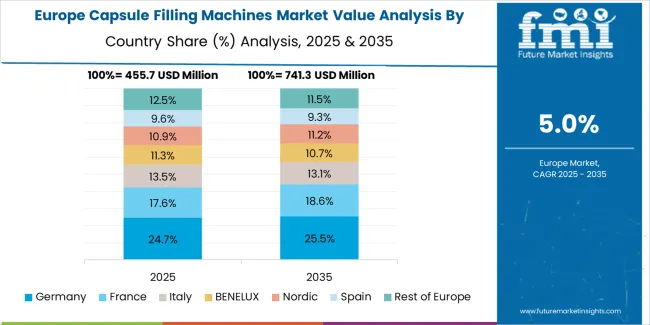
The European capsule filling machines market is projected to grow from USD 0.6 billion in 2025 to USD 1.0 billion by 2035, registering a CAGR of 5.4% over the forecast period. Germany is expected to maintain its leadership position with a 35.8% market share in 2025, supported by its advanced pharmaceutical technology infrastructure and major manufacturing centers.
United Kingdom follows with a 22.1% share in 2025, driven by comprehensive pharmaceutical programs and manufacturing technology development initiatives. France holds a 18.4% share through specialized pharmaceutical applications and quality compliance requirements. Italy commands a 12.9% share, while Spain accounts for 10.8% in 2025. The rest of Europe region is anticipated to gain momentum, expanding its collective share from 6.3% to 6.8% by 2035, attributed to increasing pharmaceutical adoption in Nordic countries and emerging pharmaceutical facilities implementing manufacturing modernization programs.
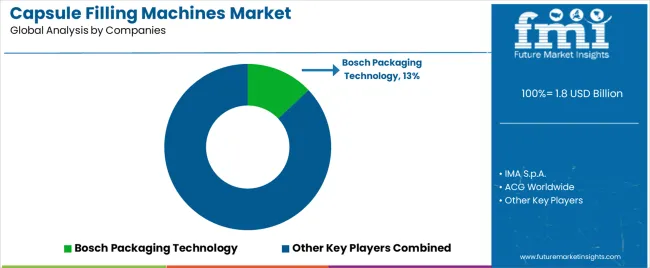
| Stakeholder | What they actually control | Typical strengths | Typical blind spots |
|---|---|---|---|
| Global platforms | Distribution reach, deep product catalogs, service depots | Broad availability, proven reliability, multi-region support | Technology refresh cycles; customer lock-in dependency |
| Technology innovators | R&D capabilities; high-speed/precision systems; clean digital interfaces | Latest features first; attractive ROI on high-volume production | Service density outside core regions; customization complexity |
| Regional specialists | Local compliance, fast delivery, nearby technicians | "Close to site" support; pragmatic pricing; local regulations | Technology gaps; talent retention in service |
| Service-focused ecosystems | Validation support, maintenance SLAs, spare parts availability | Lowest real downtime; comprehensive support | Service costs if overpromised; technology obsolescence |
| Niche specialists | Specialized applications, custom solutions, R&D support | Win research/development applications; flexible configurations | Scalability limitations; narrow market focus |
| Item | Value |
|---|---|
| Quantitative Units | USD 1.8 billion |
| Machine Type | Automatic, Semi-Automatic, Manual |
| Capacity | Low Capacity (up to 25K capsules/hour), Medium Capacity (25K-100K capsules/hour), High Capacity (above 100K capsules/hour) |
| Capsule Size | Size 00, Size 0, Size 1, Size 2, Size 3, Size 4 |
| End Use | Pharmaceutical Companies, Contract Manufacturing Organizations, Nutraceutical Companies, Research Institutions |
| Regions Covered | North America, Latin America, Western Europe, Eastern Europe, East Asia, South Asia Pacific, Middle East & Africa |
| Countries Covered | United States, China, Germany, India, United Kingdom, Japan, Canada, Brazil, France, Australia, and 25+ additional countries |
| Key Companies Profiled | Bosch Packaging Technology, IMA S.p.A., ACG Worldwide, Capsugel (Lonza), MG2 S.r.l., Qualicaps Co., Ltd., Harro Höfliger Verpackungsmaschinen GmbH, Torpac Inc., CapsulCN International |
| Additional Attributes | Dollar sales by machine type and capacity categories, regional adoption trends across North America, East Asia, and Western Europe, competitive landscape with pharmaceutical equipment manufacturers and contract manufacturing suppliers, pharmaceutical operator preferences for precision filling control and system reliability, integration with pharmaceutical platforms and quality monitoring systems, innovations in filling technology and precision enhancement, and development of automated filling solutions with enhanced performance and pharmaceutical optimization capabilities. |
The global capsule filling machines market is estimated to be valued at USD 1.8 billion in 2025.
The market size for the capsule filling machines market is projected to reach USD 3.2 billion by 2035.
The capsule filling machines market is expected to grow at a 5.9% CAGR between 2025 and 2035.
The key product types in capsule filling machines market are automatic, semi-automatic and manual.
In terms of capacity, medium capacity (25,000 to 100,000 capsules/hour) segment to command 6.8% share in the capsule filling machines market in 2025.






Full Research Suite comprises of:
Market outlook & trends analysis
Interviews & case studies
Strategic recommendations
Vendor profiles & capabilities analysis
5-year forecasts
8 regions and 60+ country-level data splits
Market segment data splits
12 months of continuous data updates
DELIVERED AS:
PDF EXCEL ONLINE
Market Share Breakdown of Capsule Filling Machine Manufacturers
Liquid Capsule Filling Machines Market Trends – Growth & Forecast 2025 to 2035
Hardgel Liquid Capsule Filling Machines Market
Capsule Vision Inspection Solution Market Size and Share Forecast Outlook 2025 to 2035
Capsule Hotels Market Size and Share Forecast Outlook 2025 to 2035
Capsule Endoscope and Workstations Market - Growth & Demand 2025 to 2035
Capsule Coffee Machines Market
Wine Capsule Market Insights – Trends & Forecast 2024-2034
Resin Capsule Market Forecast and Outlook 2025 to 2035
Empty Capsule Market Report - Growth, Demand & Forecast 2025 to 2035
Flavor Capsule Cigarette Market Analysis - Size, Share, and Forecast 2025 to 2035
Coffee Capsules Market Analysis - Growth & Forecast 2025 to 2035
Coffee Capsules and Pods Market
Flavor Capsule Cigarettes Market
Washing Capsules Market Size and Share Forecast Outlook 2025 to 2035
Softgel Capsules Market Overview - Growth & Forecast 2025 to 2035
Cryogenic Capsules Market Growth - Demand & Forecast 2025 to 2035
Market Share Distribution Among Tablets And Capsules Packaging Companies
Tablets and Capsules Packaging Market Growth, Trends, Forecast 2025-2035
Hard Gelatin Capsules Market Analysis - Size, Share, and Forecast Outlook 2025 to 2035

Thank you!
You will receive an email from our Business Development Manager. Please be sure to check your SPAM/JUNK folder too.
Chat With
MaRIA